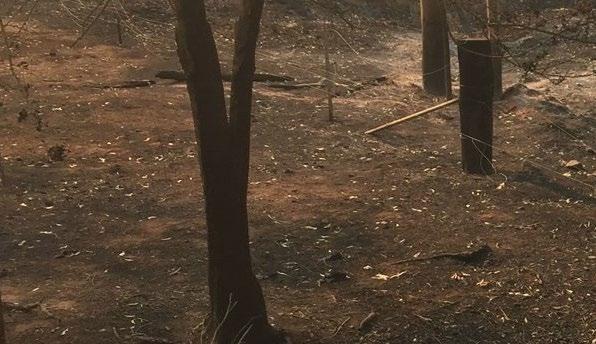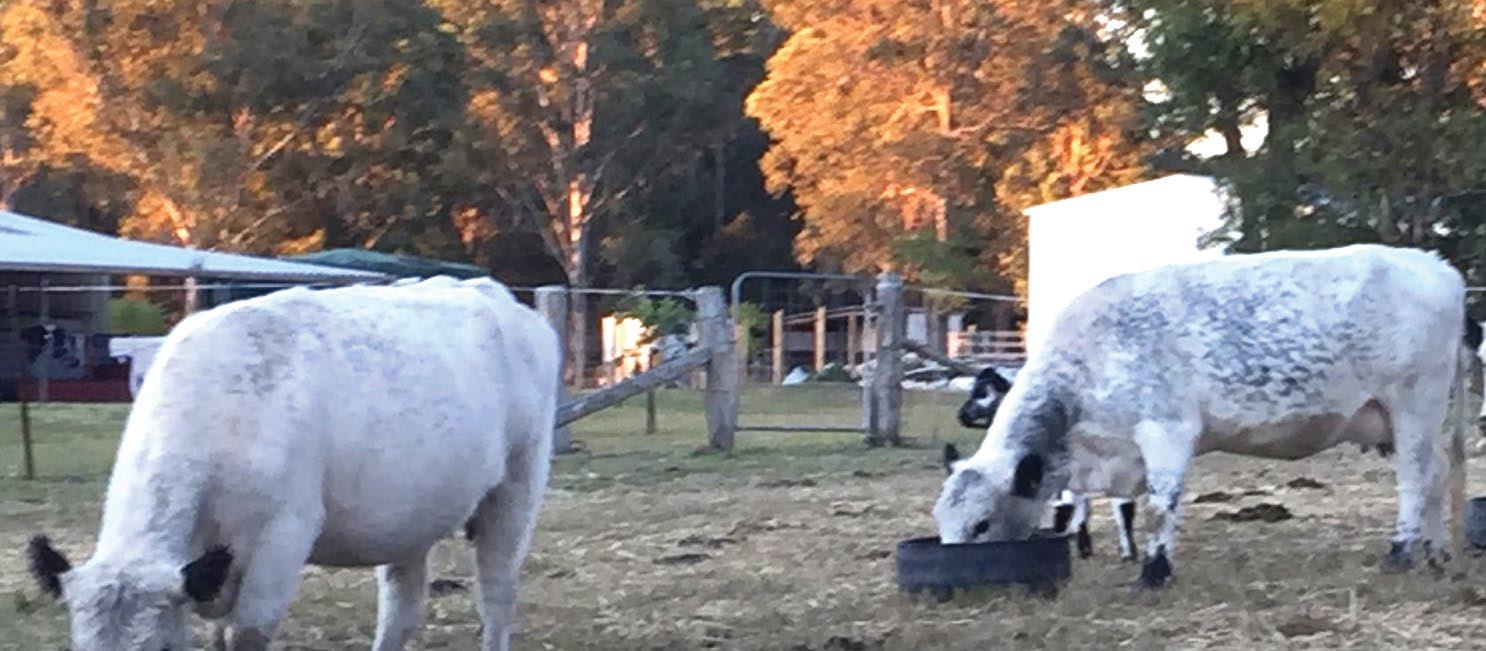
9 minute read
Re-building herds after adversity
In recent times there have been a number of natural disasters around Australia. For example, ongoing drought conditions across much of the eastern states, localised flooding in large areas of northern Australia and, more recently, widespread bushfires.
In addition, disease outbreak is an ever present risk which can also lead to a loss of breeding animals. SBTS and TBTS want to acknowledge the difficulties faced by those affected by all natural disasters and to offer advice on artificial breeding and genetic strategies that may assist in the recovery of valuable breeding herds.
Artificial Breeding
Artificial breeding techniques can assist with rebuilding a herd after adversity. While artificial breeding has numerous advantages, it does require an investment of time and money, which may not be suitable after a period of adversity and its associated challenges. Additionally, if cows are in poor condition, the conception rates from an artificial breeding program may be negatively affected.
Fortunately, mature cows typically recover body condition quickly but there are a number of considerations when mating maiden heifers. The following considerations apply to both natural service and artificial breeding programs in heifers:
They should be at sufficient joining weight: it is weight, not age that triggers puberty. This might be tough if young heifers have had their growth stunted due to adversity and/or have been weaned early
Ideally, heifers should be gaining weight at the time of joining
Mating heifers, particularly those that have had a growth check, requires an increased emphasis on calving ease in the bulls used.
Artificial Insemination (AI) – AI can be used in herd recovery in multiple ways. Firstly, AI can allow the use of sires that are no longer physically available, allowing breeders to reintroduce certain blood lines. This requires some preplanning as semen needs to be collected (if possible) before the bull is removed from the enterprise. This illustrates the value of maintaining a genetic bank of your top bulls as insurance against their loss.
Secondly, sexed semen can be used to influence the progeny sex ratio and is offered by a number of semen resellers. There are a number of scenarios where producing single sex progeny can be extremely valuable when recovering from adversity. They include:
Where the reduction in herd size means there are insufficient cows to produce enough bulls (assuming a normal 50:50 sex ratio) to meet expected sales, using male-sexed semen will increase the proportion of males born in order to meet the sales targets. However, this

will occur at the cost of available female replacements from which to choose
The opposite approach is to use female-sexed semen to produce more heifers. This will allow breeders to quickly build their breeding herds back to their normal size and/ or sell heifers to others. With the reduction in female numbers due to recent adversity, such heifers are likely to be more valuable in the short term than steers
In a commercial herd, a breeder may also choose to utilise sexed semen to maximise the number of steers they produce while the overall industry population is reduced and the steers are consequently in high demand. If male calves are desired, it may be appropriate to use your older cows as male calves are typically bigger at birth and thus, more likely to cause calving issues. The likelihood of calving issues can also be influenced by bull choice
Alternatively, sexed semen could be used to produce commercial crossbred heifers without the need to buy and run bulls of different breeds.
the semen into sperm cells, those being an X chromosome (female) and a Y chromosome (male). The semen sexing process has an accuracy of over 90% and identifies the Y chromosome through it being lighter and having a negative electrical charge. A fluorescent dye is also added that binds to the DNA.
Roughly 15 - 18% of the total semen sold within the Australian dairy industry is now sexed semen (DataGene, December 2019) and trials have shown that the conception rate using sexed semen is approximately 90% of that expected using normal semen. Additionally, sexed semen typically costs about twice as much per straw to acquire than normal semen.
Embryo Transfer (ET) – ET allows multiple progeny to be produced from an individual cow each year. This is advantageous in scenarios where the size of the seedstock cow herd has been reduced but commercial cows are available to implant embryos into. Like AI but on a greater scale, there are financial and time costs involved with an ET program and there can also be additional breed society regulations (some mandate DNA testing) and BREEDPLAN recording (of recipient dams) required. Each ET cycle takes about 25 days. In herds where the only available animals of sufficient genetic merit are young heifers, Juvenile In Vitro Fertilisation and Embryo Transfer (JIVET) may be a suitable option, as embryos can be harvested from sexually immature females. The production of sexed semen involves a machine that sorts
Sexed semen can also be utilised to create sexed embryos that combine the benefits of sexed semen and ET. However, Dominic Bayard from Global Reproduction Solutions (GRS) recommends that up to three straws of sexed semen are used per donor and that better results are achieved by
fertilising the embryos a little later in the heat window. GRS also offers a service that tests the gender of each embryo via an embryo biopsy and subsequent DNA test. This is useful for breeders who only have mixed-sex semen or embryos available to them but has the disadvantage in that half the embryos produced are not of the desired sex.
Breeding Objectives Following Herd Reduction
While undesirable, a herd rebuild does present opportunities to improve key components of the breeding program. After all, there is little value in rebuilding seedstock herds with cows that are not suitable for producing profitable offspring. Having the right selection objective for the herd’s future, pedigree (for genetic diversity and inbreeding avoidance), genetic condition status and accurate measures of genetic merit are all important to ensure a successful future and should be addressed at this time.
Selection Objectives – Long term forecasts suggest that extreme weather events (e.g. flood and drought) are likely to be more frequent and severe. So then, what should be the breeding objectives for the future beef animal? Should our objectives include more emphasis on reducing cow mature size and greenhouse gas emissions and improving fertility, adaption and health traits? We are also starting to see an increased push into value-based marketing, so should carcase traits be given more emphasis? There will be no one right answer for all herds and breeds and individual breeders are encouraged to think about both themselves and the future requirements of their clients when determining future selection direction(s).
Genetic Diversity and Inbreeding – Heavy culling typically reduces the amount of genetic diversity in a herd as most of the animals that remain will come from the same highmerit families. This has a number of implications for the herd.
Firstly, genetic diversity is a key requirement for avoiding inbreeding and the expression of genetic conditions. Secondly, genetic diversity drives genetic progress because the greater the difference between the top and bottom animals, the more genetic gain is achieved by culling the bottom animals and/or retaining those at the top.
While artificial breeding can be extremely useful, it can reduce the genetic diversity of a herd because individual sires and dams can become parents of more progeny than they would naturally. Thus, full and half siblings will form a greater proportion of the herd and result in less genetic diversity than would occur if only natural mating is utilised.
There are multiple strategies that can be employed to mitigate this. Ensuring that more than one AI sire is used, multiple donor dams for ET programs and/or multiple sires in a single donor ET flush. Some of these strategies will also increase the accuracy of the genetic evaluation by providing more linkage.
Another possible strategy is to utilise mate selection software like MateSel (see p15) which balances inbreeding and genetic diversity levels against genetic progress when determining mating lists.
Genetic Conditions – The culling within a herd in response to adversity is a good opportunity to remove those animals that are carriers for genetic conditions, though this requires knowledge of the genetic condition status of the animals under consideration. Knowledge of the genetic condition status can be achieved via genetic testing (costly,

particularly for animals that may be culled), GeneProb results (where available) or by knowledge of affected family lines (less accurate).
Accurate measures of genetic merit – With artificial breeding, each mating decision can result in more progeny than is the case with natural mating. Thus it is important that selection decisions are made from the most accurate data possible.
on the resulting breeding values. Genetic evaluations use as the animals will rank similarly to what they would in a normal year.
Performance Recording During and After Adversity
Understandably, performance recording is likely to be a low priority compared with other tasks in the immediate aftermath of a natural disaster. During the recovery stage, where some time may be available for performance recording, producers may wish to focus on the recording of a subset of key traits and/or a subset of animals.
For example, a breeder could chose to concentrate their calving ease and birth weight recording in the maiden heifer mob where these traits are most relevant, or to concentrate their growth recording on the bulls as these are the future sale animals.
While not recommended for the long term, these strategies may help producers to record some information until they can return to their full performance recording schedule. Of course, it is important to be aware of the dangers of selective recording; as long as the subset being recorded represents the whole management group (mob), this is unlikely to be an issue (for more information, please see the Understanding BREEDPLAN Management Groups tip sheet on the BREEDPLAN website or contact SBTS or TBTS As natural disasters and disease typically have a negative effect upon performance (e.g. lighter weights), it is important to note that this will not have an adverse influence comparisons between animal performance in each group, rather than the absolute values. As long as every animal in each management group has had an equal opportunity to perform, the adverse conditions will not affect their EBVs
staff).
Some other points to consider when recording animals after adversity include:
Agistment – management groups should be recorded to differentiate animals on agistment from those remaining at home, or those in different mobs/locations on agistment
Early weaning – with feed in short supply, one option is to wean calves early to give the cows the best chance at rebreeding. For BREEDPLAN purposes, the 200 day weight of a group can be recorded as soon as the youngest calf reaches 80 days of age and does not have to be carried out at weaning
Sick/injured – if the health of individual animals is affected, then these animals should be recorded as being in separate management groups
Ultrasound scanning – requires animals to have a minimum average rump fat depth of 4 – 5 mm. This ensures that there will be sufficient variation between animals to allow genetic differences to show up.
Courtesy SBTS.







